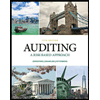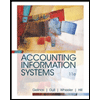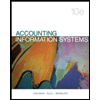
Case summary:
The technology summary states that there are two different types of process controls that are automated controls and manual controls. Ability, training, and diligence of the data entry person determine the efficiency of the manual control. The data entry person should know the approval that is valid and document that is not properly approved. The person should compare the input data with the master data to correct the errors in the input data.
In automated controls, all the controls of the firms will be performed by the computer system. Digital signatures, electronic approvals, programmed edit checks, and comparing input data with the master data are included in the automated controls.
To describe: The impact that pervasive and general controls have on the effectiveness of controls.
Introduction:
Want to see the full answer?
Check out a sample textbook solution
Chapter 9 Solutions
Accounting Information Systems
- When the price of a bond is above the face value, the bond is said to be* Trading at par Trading at a premium Trading at a discount Trading below pararrow_forward7. What is a par value of a bond?* The amount borrowed by the issuer of the bond and returned to the investors when the bond matures The overall return earned by the bond investor when the bond matures The difference between the amount borrowed by the issuer of bond and the amount returned to investors at maturity The size of the coupon investors receive on an annual basisarrow_forwardWhat is an annuity?* An investment that has no definite end and a stream of cash payments that continues forever A stream of cash flows that start one year from today and continue while growing by a constant growth rate A series of equal payments at equal time periods and guaranteed for a fixed number of years A series of unequal payments at equal time periods which are guaranteed for a fixed number of yearsarrow_forward
- If you were able to earn interest at 3% and you started with $100, how much would you have after 3 years?* $91.51 $109.27 $291.26 $103.00arrow_forwardNo AI 2. The formula for calculating future value (FV) is* FV = PV/(1+r)^n FV = PV/(1+r)*n FV = PV x (1+r)^n FV = PV x (1+r)*narrow_forwardDividend??? solnarrow_forward
 Auditing: A Risk Based-Approach (MindTap Course L...AccountingISBN:9781337619455Author:Karla M Johnstone, Audrey A. Gramling, Larry E. RittenbergPublisher:Cengage Learning
Auditing: A Risk Based-Approach (MindTap Course L...AccountingISBN:9781337619455Author:Karla M Johnstone, Audrey A. Gramling, Larry E. RittenbergPublisher:Cengage Learning Accounting Information SystemsFinanceISBN:9781337552127Author:Ulric J. Gelinas, Richard B. Dull, Patrick Wheeler, Mary Callahan HillPublisher:Cengage Learning
Accounting Information SystemsFinanceISBN:9781337552127Author:Ulric J. Gelinas, Richard B. Dull, Patrick Wheeler, Mary Callahan HillPublisher:Cengage Learning Accounting Information SystemsAccountingISBN:9781337619202Author:Hall, James A.Publisher:Cengage Learning,
Accounting Information SystemsAccountingISBN:9781337619202Author:Hall, James A.Publisher:Cengage Learning, Pkg Acc Infor Systems MS VISIO CDFinanceISBN:9781133935940Author:Ulric J. GelinasPublisher:CENGAGE LPrinciples of Accounting Volume 2AccountingISBN:9781947172609Author:OpenStaxPublisher:OpenStax College
Pkg Acc Infor Systems MS VISIO CDFinanceISBN:9781133935940Author:Ulric J. GelinasPublisher:CENGAGE LPrinciples of Accounting Volume 2AccountingISBN:9781947172609Author:OpenStaxPublisher:OpenStax College





